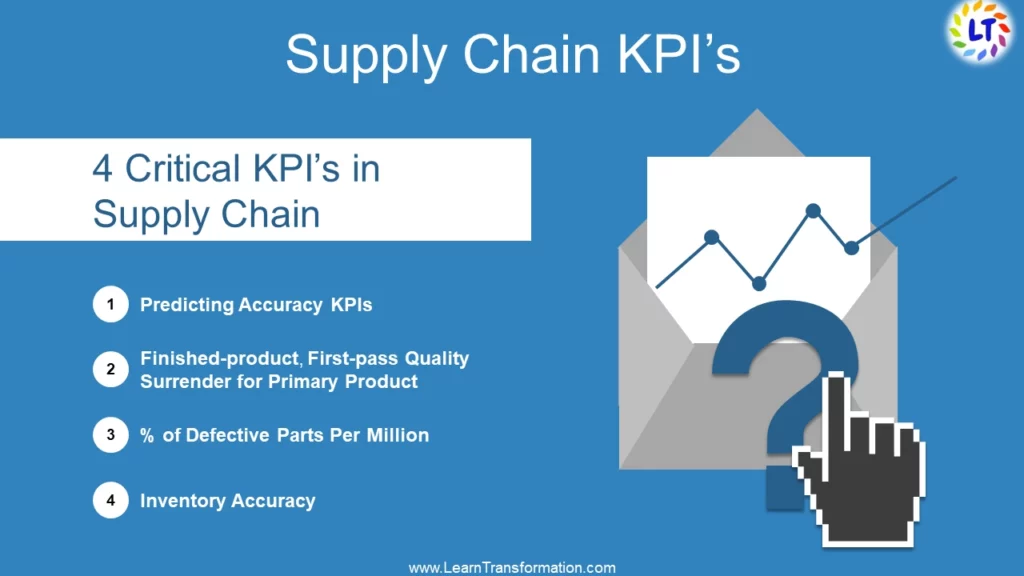“Deep learning will revolutionize supply chain automation”
Dave Waters
Revamp Your Supply Chain with Effective Key Performance Indicators (KPIs)
The Supply Chain KPIs are a measure that defines & evaluates how successful an organization is. In today’s highly global & competitive marketplace, most businesses have noticed the value of investing in supply chain improvement. If investments is make, then an evaluation of their returns must be there. Due to this, many businesses have also developed metrics that record real-world supply chain transformation performance & track the changes.
- Revamp Your Supply Chain with Effective Key Performance Indicators (KPIs)
- Defining Key Performance Indicator
- Why are KPIs important?
- What is Good KPI?
- Difference Between KPI & Metrics
- Some Important Supply Chain Metrics
- KPI in Supply Chain & Logistics
- What are the 7 key performance indicators in supply chain?
- How do you measure KPI in supply chain?
Defining Key Performance Indicator
KPIs are the evaluative indicators of progress regarding a calculated result.
- Performance Indicators defines & measure progress regarding organizational objectives. After analyzing its objectives & mission, an organization requires to measure progress towards these objectives. So, Peroformance Indicators provide a measurement tool.
- Performance Indicators helps an organization to measure that it’s ‘on track’. In various cases, we use these indicators in projects and to measure service delivery.
There are so many indicators available to organizations today ranging from HR, financial, sales & marketing, operations, and so on. But which best suits for your organization? KPI’s are about process, not goals.
Why are KPIs important?
- It provides a good indication of performance.
- It’s generally used in business.
- It’s a metric to define & measure business objectives.
What is Good KPI?
- Measure what’s intended to measure to help in better decision making.
- Offers objective evidence of progress towards attaining a desired outcome.
- Provides a comparison which measures the degree of performance change over time.
- Track’s efficiency, timeliness, quality, economics, personnel or project performance, behaviors, resource utilization.
Key performance metrics in supply chain provides a center of attention for operational & strategic enhancement, develop an analytical basis for decision making & help focusing on what be the most important activity.
Difference Between KPI & Metrics
- Both are not identical. A metric is used to measure supply chain performance measurement of the particular part of a supply network operation. It can be this simple as the departure time of a transport or the correct completion of a document.
- While KPI is a metric that you chose that will provide an indication of your performance & can be utilized as a driver for improvement. In general it’s preferred to select a few indicators (say 4 or 5) to concentrate on.
So, not all metrics are KPIs but all KPIs are metrics. At most the essential metrics can progress to become KPIs.
Also Read: Just In Time(JIT) Methodology Of Toyota, McDonalds & Apple
Some Important Supply Chain Metrics
Supply chain performance metrics can help recognize the weak links in the supply network. Part of the challenge is trying to riddle out the connection between what you’re measuring & the objectives of the organization. There are so many different things that you can measure, but the essential thing is finding out the (1-5) things that you can measure, that you can measure daily, and that will really push your organization forward from a customer & shareholder perspective for a better organization transformation.
So how can an organization best select & implement indicators that enhance operational performance & drive business strategy? In another words, how do they know it’s profitable?
Let’s examine 2 different types of performance indicators associated with process efficiency and cost effectiveness. Process efficiency key indicators gauges the performance of supply chain organization. Cost effectiveness key indicators permits for an organization to better manage & gauge their cost-effectiveness performance, both internally & externally. Described below are a few specific performance indicators in supply network & logistics generally used across supply chains to measure quality of products, processes & design, to detect and minimize company risks and improve customer experience.

1. Inventory Accuracy
It mentions to the in-stock or out-of-stock accuracy of supplier inventory. This indicator should highest possible, showing precise inventory at hand for consumers.
2. Finished-product, First-pass Quality Surrender for Primary Product
First pass yield measures how many units finishe in the first pass through each & every step in the Supply chain with no rework. If an organization doesn’t measure final-product, first-pass yield, it risks high levels of process inefficiency & waste. First-pass yield helps companies to identify high-waste & low-efficiency areas.
3. % of Defective Parts Per Million
% of defective parts per million is a KPI which measures the number of defective parts out of complete parts produced. Further, This Performance Indicator in supply network focuses on the quality of the process & output before the product is shipp. The supply chain transformation group has to ensure they are sourcing the right parts to decrease the overall number of defective parts.
4. Predicting Accuracy KPI
Various marketing streams collect information, including data analytics, should be leveraged to create demand forecasts that adapt to changes in the market. For instance, trends on social media might indicate a possible shift in demand, generating a new forecast.
Hand-picked for you: Supply Chain Management in VUCA World
Leader’s Tip:
Select and monitor pertinent KPIs in line with strategy goals to track and enhance supply chain performance.
KPI in Supply Chain & Logistics
In Logistics environment, an example of a business objective may be to add value to the organization by offering the most cost-efficient & service-effective logistics capability. The organization can strive to attain that strategic objective by meeting tactical goals, such as having the ability to provide goods delivery on time in any country, obtaining the lowest costs for the service offer. Moreover, As suggested by its very name, the key performance indicators in supply chain & logistics indicate how well the organization is performing against these & other types of business objectives.
The chosen performance indicators should benefit all parties engaged, not just the party paying for the move. Besides, KPIs should make each of the entities involved in the logistics chain aware of what the complete measurement is & how they contribute to the success (or failure) of the whole supply chain transformation.
What are the 7 key performance indicators in supply chain?
Managements use Key performance indicators (KPIs) to measure and evaluate the success of a company’s supply chain management. Thus, Here are seven important KPIs that can help organizations optimize their supply chain performance:
Order Cycle Time: This measures the time it takes from the receipt of an order to the delivery of the product. A shorter order cycle time indicates a more efficient supply chain.
Inventory Accuracy: This measures the accuracy of inventory levels in the warehouse and throughout the supply chain. Accurate inventory levels help to prevent stockouts and overstocking, which can be costly.
Delivery In Full On Time (DIFOT): This measures the percentage of orders that are delivered on time and in full. DIFOT helps to measure the effectiveness of the supply chain in meeting customer demand.
Cash-to-Cash Cycle Time: This measures the amount of time it takes for cash to flow from customers to suppliers. So, Shorter cycle times can help to improve cash flow and increase the profitability of the organization.
Order Fill Rate: This measures the percentage of customer orders that are fill correctly. Furthermore, A high order fill rate indicates that the supply chain is effective in meeting customer demand.
Cost of Goods Sold (COGS): This measures the cost of producing and delivering products to customers. Monitoring COGS can help organizations to identify opportunities to reduce costs and improve profitability.
Perfect Order Rate: This measures the percentage of orders that did delivery on time, in full, and without any errors. A high perfect order rate indicates a highly effective supply chain.
By monitoring and measuring these KPIs, organizations can identify areas for improvement in their supply chain management as well as work towards optimizing their performance.
How often leaders should review KPIs in supply chain management?
KPIs should be reviewed on a regular basis. Typically monthly or quarterly, to ensure they remain relevant and aligne with business objectives. However, in certain situations such as during major supply chain disruptions, KPIs may need to reviewe and update more frequently.
KPIs usage in supply chain management
Generally, We use KPIs to monitor and measure supply chain performance, identify areas for improvement, and track progress toward supply chain goals and objectives.
How do you measure KPI in supply chain?
Further, Measuring KPIs in supply chain involves setting up metrics to track performance over time. So, Here are some steps that can measure KPIs in supply chain:
Define your objectives: Firstly, you need to determine what you want to achieve with your KPIs. Set clear objectives for each KPI, and make sure they align with your overall business goals.
Determine the metrics: Once you have defined your objectives, determine the metrics that will help you measure progress toward those objectives. For example, if your objective is to reduce order cycle time, the metric could be the number of days from order receipt to order delivery.
Collect data: Collect data on the chosen metrics. Moreover, This can involve implementing a system to capture data automatically or manually collecting data using spreadsheets or other tools.
Analyze the data: Once you have collected the data, analyze it to determine the performance of the supply chain against each KPI. Then, Identify trends as well as areas for improvement.
Take action: Based on your analysis, take action to improve performance in areas that are underperforming. Set new targets and continue to monitor and measure progress over time.
Review and refine: Regularly review and refine your KPIs to ensure they are still relevant and aligned with your business objectives.
Also Check:35 Best Leadership Books of All Time
Leader’s Tip:
Analyse KPI data often to spot problem areas, put remedial measures in place, and promote operational excellence.
Final Word
At last, Supply chains have the capacity to make or break an organization. Hence, The delivery colossus is raising expectations of how quickly products can be delivered and how cheaply. As a result, the supply chain is becoming more important than ever and they need to be carefully managed for successful transformation in an organization.
Frequently Asked Questions
What are the four indicators used in measuring supply chain performance?
Supply chain performance metrics can help recognize the weak links in the supply network.
- Inventory Accuracy
- Finished-product, First-pass Quality Surrender for Primary Product
- % of Defective Parts Per Million
- Predicting Accuracy KPIs
Why is KPI important?
- It provides a good indication of performance.
- It’s generally used in business.
- It’s a metric to define & measure business objectives.
What are the challenges in selecting and using KPIs in supply chain management?
Challenges in selecting and using KPIs in supply chain management include choosing KPIs that are aligned with business objectives, ensuring data accuracy and consistency, and avoiding the overuse of KPIs which can lead to information overload.
Why are KPIs important in supply chain management?
KPIs help companies monitor and evaluate their supply chain performance, identify areas for improvement, and make data-driven decisions. KPIs are important in supply chain management because they help managers stay informed about performance, make better decisions, and ultimately drive improvement across the supply chain.
Key Takeaways
- Key supply chain elements including cost, quality, delivery, and customer satisfaction are all revealed through KPIs.
- Choose KPIs that support the overarching aims and objectives of the organisation that are measurable, meaningful, and aligned with them.
- KPIs are continuously monitored and benchmarked to support proactive decision-making and ongoing improvement projects.

